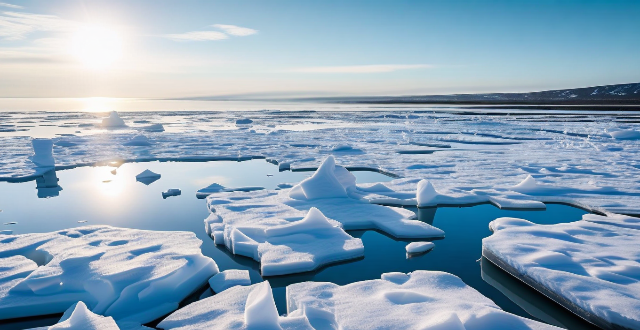The polar ice caps are melting due to global warming, causing sea levels to rise and threatening coastal communities and ecosystems. The Greenland and Antarctic ice sheets are losing mass at an accelerating rate, contributing significantly to rising sea levels. This has significant implications for both the environment and human societies around the world. Rising sea levels pose serious threats such as coastal erosion, saltwater intrusion, loss of wetlands and mangrove forests, and displacement of coastal communities. To mitigate these impacts, urgent action must be taken to reduce greenhouse gas emissions and transition to cleaner energy sources.

Impact of Climate Change on Polar Ice Caps and Sea Levels
The polar ice caps are one of the most visible indicators of climate change, as they play a crucial role in regulating Earth's temperature and weather patterns. In recent years, the melting of these ice caps has been accelerating at an alarming rate due to global warming caused by human activities such as burning fossil fuels and deforestation. This melting has significant implications for both the environment and human societies around the world.
Melting of Polar Ice Caps
Greenland Ice Sheet
The Greenland Ice Sheet is one of the largest ice caps in the world, covering an area roughly three times the size of Texas. It has been losing mass at an increasing rate over the past few decades, with some estimates suggesting that it could lose up to 10% of its total volume by 2100 if current trends continue. This loss of ice contributes significantly to rising sea levels, which can have devastating effects on coastal communities and ecosystems.
Antarctic Ice Sheet
The Antarctic Ice Sheet is even larger than the Greenland Ice Sheet, covering about 98% of all freshwater on Earth. Like its northern counterpart, the Antarctic Ice Sheet is also experiencing rapid melting due to global warming. However, because it is located further south where temperatures are generally colder, the rate of melting is slower than in Greenland. Nonetheless, scientists predict that the Antarctic Ice Sheet will continue to lose mass over the coming centuries, contributing to rising sea levels and potentially triggering feedback loops that could accelerate this process.
Rising Sea Levels
Causes of Sea Level Rise
Sea level rise is primarily caused by two factors: thermal expansion (as water warms, it expands) and the addition of water from melting glaciers and ice caps. While thermal expansion accounts for about half of current sea level rise, melting ice caps are responsible for most of the remaining increase. As these ice caps continue to lose mass, they will add more water to the oceans, causing sea levels to rise even further.
Effects of Sea Level Rise
Rising sea levels pose serious threats to coastal communities and ecosystems around the world. Some of the potential impacts include:
- Coastal Erosion: Higher sea levels can cause increased wave action and storm surges, leading to shoreline erosion and damage to infrastructure such as roads, buildings, and pipelines.
- Saltwater Intrusion: As sea levels rise, saltwater can intrude into freshwater sources used for drinking water, agriculture, and other purposes. This can lead to contamination and reduced availability of freshwater resources.
- Loss of Wetlands and Mangrove Forests: These ecosystems play important roles in protecting coastlines from storms and erosion, providing habitat for wildlife, and supporting fisheries. Rising sea levels can cause them to be submerged or otherwise damaged beyond repair.
- Displacement of Coastal Communities: In some areas, rising sea levels may make it necessary for people living in low-lying regions to relocate or face increasingly frequent flooding events.
In conclusion, climate change has had a profound effect on polar ice caps and sea levels worldwide. The melting of these ice caps is contributing significantly to rising sea levels, which pose serious threats to coastal communities and ecosystems around the world. To mitigate these impacts, it is essential that we take urgent action to reduce greenhouse gas emissions and transition to cleaner energy sources.